
Louis Comfort Tiffany was an American artist and designer who worked in the decorative arts and is best known for his work in stained glass. He is the American artist most associated with the Art Nouveau and Aesthetic movements. He was affiliated with a prestigious collaborative of designers known as the Associated Artists, which included Lockwood de Forest, Candace Wheeler, and Samuel Colman. Tiffany designed stained glass windows and lamps, glass mosaics, blown glass, ceramics, jewellery, enamels, and metalwork. He was the first design director at his family company, Tiffany & Co., founded by his father Charles Lewis Tiffany.

The Chicago Cultural Center, opened in 1897, is a Chicago Landmark building operated by Chicago's Department of Cultural Affairs and Special Events that houses the city's official reception venue where the Mayor of Chicago has welcomed presidents and royalty, diplomats and community leaders. It is located in the Loop, across Michigan Avenue from Millennium Park. Originally the central library building, it was converted in 1977 to an arts and culture center at the instigation of Commissioner of Cultural Affairs Lois Weisberg. The city's central library is now housed across the Loop in the spacious, postmodern Harold Washington Library Center opened in 1991.

The Arlington Street Church is a Unitarian Universalist church across from the Public Garden in Boston, Massachusetts. Because of its geographic prominence and the notable ministers who have served the congregation, the church is considered to be among the most historically important in American Unitarianism and Unitarian Universalism. Completed in 1861, it was designed by Arthur Gilman and Gridley James Fox Bryant to resemble James Gibbs' St. Martin-in-the-Fields in London. The main sanctuary space has 16 large-scale stained-glass windows installed by Tiffany Studios from 1899 to 1930.

St. Michael's Church is a historic Episcopal church at 225 West 99th Street and Amsterdam Avenue on Manhattan's Upper West Side in New York City. The parish was founded on the present site in January 1807, at that time in the rural Bloomingdale District. The present limestone Romanesque building, the third on the site, was built in 1890–91 to designs by Robert W. Gibson and added to the National Register of Historic Places in 1996.

Grace United Methodist Church is a historic church donated to the people of St. Augustine, Florida, by American industrialist Henry Morrison Flagler. It is located at 8 Carrera Street. Built within a one-year span, it was added to the U.S. National Register of Historic Places on November 29, 1979, for its architectural significance and as an example of community planning.
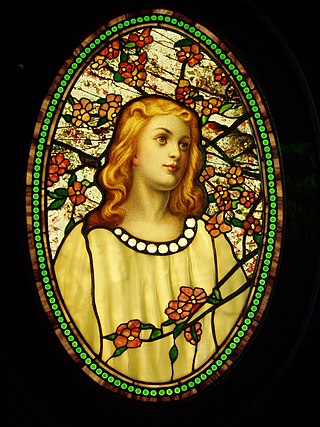
Tiffany glass refers to the many and varied types of glass developed and produced from 1878 to 1933 at the Tiffany Studios in New York City, by Louis Comfort Tiffany and a team of other designers, including Clara Driscoll, Agnes F. Northrop, and Frederick Wilson.

The Church of the Covenant is a historic church at 67 Newbury Street in the Back Bay neighborhood of Boston, Massachusetts. A National Historic Landmark, it was built in 1865-1867 by the Central Congregational Church, and is now affiliated with the United Church of Christ. The church was designed by Richard M. Upjohn, and its distinctive interior is largely the work of Tiffany & Co.
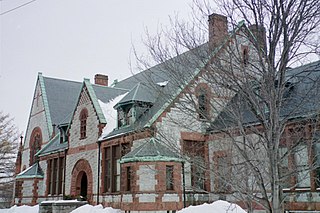
The Willard Memorial Chapel and the adjoining Welch Memorial Hall are historic conjoined buildings located at 17 Nelson Street in Auburn, Cayuga County, New York. Built 1892-94 for the Auburn Theological Seminary, the buildings contain an ecclesiastical installation of stained glass and interior decoration by Louis Comfort Tiffany that is still in its original setting. They were declared a National Historic Landmark in 2005.

Blooming Grove United Church of Christ, also known just as Blooming Grove Church and formerly known as The Congregational Church of Blooming Grove, is located at the junction of Old Dominion Road and NY 94 in the town of Blooming Grove, between the villages of Chester and Washingtonville in Orange County, New York, United States. It is a plain white Federal style building, notable for lacking the steeple or cupola commonly found on churches.
St. Michael's AnglicanChurch is a historic church and the oldest surviving religious structure in Charleston, South Carolina. It is located at Broad and Meeting streets on one of the Four Corners of Law, and represents ecclesiastical law. It was built in the 1750s by order of the South Carolina Assembly. It is listed on the National Register of Historic Places and is a National Historic Landmark.
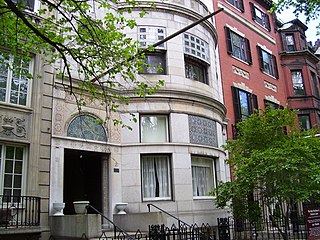
The Frederick Ayer Mansion is a National Historic Landmark on 395 Commonwealth Avenue in the Back Bay neighborhood of Boston, Massachusetts.

St. Andrew's Episcopal Church is located at the corner of Prospect and Michael Neuner streets in Brewster, New York, United States. The congregation dates, informally, to 1872, though it was not formally accepted into the American Episcopal Church until ten years later. The building itself was finished in 1903, and was listed on the National Register of Historic Places in 1998.

The Rosendale Library, formerly the All Saints' Chapel, is located on Main Street in Rosendale, New York, United States. It was originally built as a Gothic Revival Episcopal church from locally mined Rosendale cement, a material which covers the stonework exterior walls.
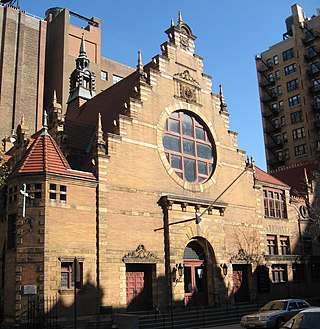
The West End Collegiate Church is a church on West End Avenue at 77th Street on Manhattan's Upper West Side. It is part of The Collegiate Reformed Protestant Dutch Church in the City of New York, the oldest Protestant church with a continuing organization in America. The Collegiate Church of New York is dually affiliated with the United Church of Christ (UCC) and the Reformed Church in America (RCA). The West End Collegiate Church is listed on the U.S. National Register of Historic Places.
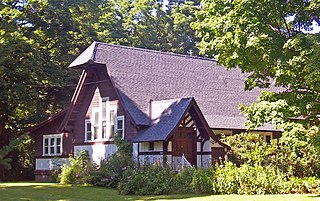
The former Trinity Episcopal Church is located on NY 23B in Claverack, New York, United States. It is a Shingle Style church building from the early 20th century.

St. Michael's Episcopal Church, Parish House and Rectory is a group of architecturally-significant religious buildings located at 200-216 North Mill Street in Birdsboro, Berks County, Pennsylvania. It was added to the U.S. National Register of Historic Places in 1982.
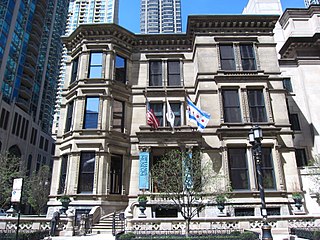
The Richard H. Driehaus Museum is a museum located at 40 East Erie Street on the Near North Side in Chicago, Illinois, near the Magnificent Mile. The museum is housed within the historic Samuel M. Nickerson House, the 1883 residence of a wealthy Chicago banker. Although the mansion has been restored, the Driehaus Museum does not re-create the Nickerson period but rather broadly interprets and displays the prevailing design, architecture, and decorating tastes of Gilded Age America and the art nouveau era in permanent and special exhibitions.
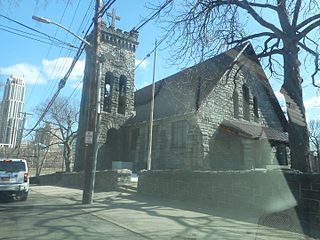
The Parish of St. Gabriel and of St. Joseph was formed in August 2015 with the merger of the Territorial parish of St. Gabriel on Division Street with the personal parish of St. Joseph on Washington Avenue, both in New Rochelle, NY. St. Gabriel is the parish church. However, St. Joseph "will maintain a regular schedule of Masses and the celebration of other sacraments". Both parishes were established around 1900 through the generosity of the Iselin family.

The historic Duluth Public Library is a former Carnegie library building at 101 West Second Street in Duluth, Minnesota, United States. It was constructed in 1902 as the first purpose-built facility of the Duluth Public Library. It was listed on the National Register of Historic Places in 1978 for its local significance in the themes of architecture and education. It was nominated for its Neoclassical architecture and association with early community education efforts.

Theodore Parker Unitarian Universalist Church is a historic church building at 1859 Centre Street in the West Roxbury neighborhood of Boston, Massachusetts. Built in 1900 to a design by West Roxbury native Henry M. Seaver, it is a locally significant example of Normanesque architecture, and is adorned by stained glass windows created by Louis Comfort Tiffany and his firm. The church was listed on the National Register of Historic Places in 2020. The congregation it houses was founded in 1712, and is named for the influential Transcendentalist and abolitionist Theodore Parker, who was the congregation's minister in the 1840s.
























